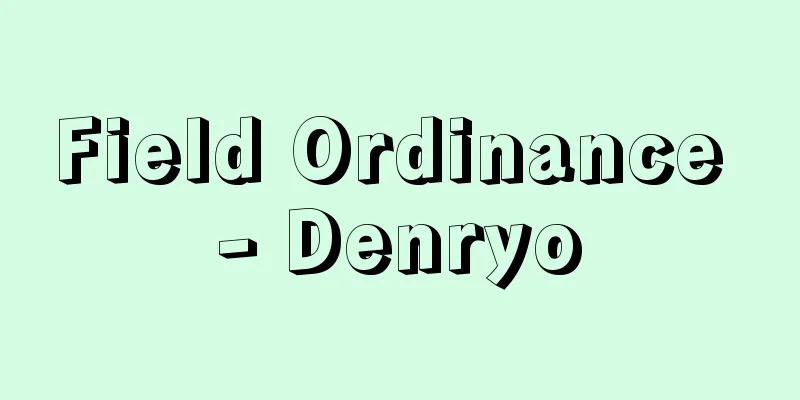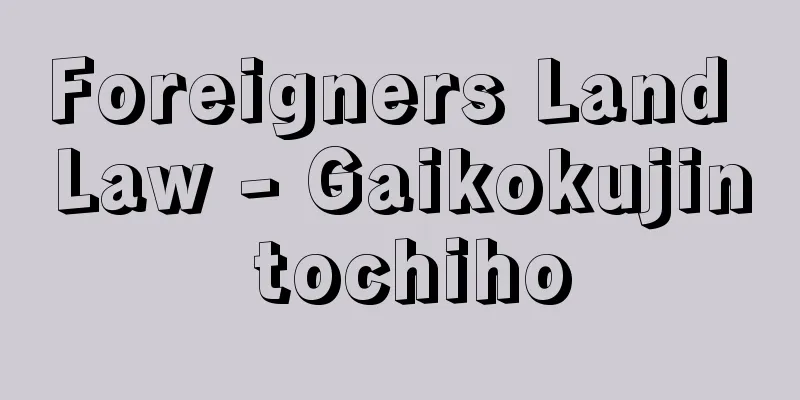Field Ordinance - Denryo

|
(1) One of the sections of the Code. In the "Yoro Code" (Chapter 30), it is arranged between the House Code and the Bunyaku Code, and is the ninth article, with a total of 37 articles. It starts with the unit of rice field area, and stipulates the regulations for land, such as kubunden (rice field), kouden (rice field), shikiden (rice field), and iden (rice field), as well as the regulations for abandoned fields and vacant land, and the usufruct laws. It is noteworthy that the provisions regarding the rice field tax are included in the Rice Field Code. This is because in the parent law, the Tang Code, the levy criteria and collection methods for the tax were stipulated in the Bunyaku Code. This shows that under the ancient Japanese Ritsuryo system, the tax was not considered a tax. In relation to this point, in the Tang Code, there is a close relationship between the qualifications to receive rice fields and the tax assessment burden, while in Japan, the relationship between the two is weak, which is another difference between the two. (2) The reading is "tasukei". Before the establishment of the Ritsuryo system, this was an official dispatched by the central government to manage Miyake, a territory directly controlled by the Imperial family. The first appearance of this was in the entry for July, 556, in the 17th year of the reign of Emperor Kinmei in the Nihon Shoki, which states that Katsuragi Yamada Naotai Mizuko was appointed as the field chief of the Miyake established in Kojima County, Bizen (Kojima County, Okayama Prefecture). The entry for April, 701, in the Shoku Nihongi states that "the fields were abolished and left to the inspection by the kokushi." If the fields were the same as the field chiefs, then it can be assumed that they continued to exist until the implementation of the Taiho Code, and that their duties were taken over by the kokushi. In addition, in the 30th year of the reign of Emperor Kinmei (569), Itsutsu, who was dispatched to the Shirai Tonokura in Kibi, was given the surname Fuhito in recognition of his achievement in establishing the family register of the Tabe region, and was appointed as a field governor and adjutant to Katsuragi Yamada Naomizuko. [Takeshi Fukuoka] "Ritsuryo" edited by Mitsusada Inoue et al. (1976, Iwanami Shoten) Source: Shogakukan Encyclopedia Nipponica About Encyclopedia Nipponica Information | Legend |
|
(1)令の篇目(へんもく)の一つ。「養老(ようろう)令」(30編)にあっては、戸令と賦役令の間、第九番目に配列されており、全37か条よりなっている。田の面積の単位から始まり、口分田(くぶんでん)や功田(こうでん)・職田(しきでん)・位田(いでん)など各種の田、あるいは荒廃田、空閑地に至る土地の規定、用益法などについて定めたもの。田租(でんそ)に関する規定がこの田令に含まれていることが注目される。母法たる唐令では、租の賦課規準や徴収法は賦役令において定められているからである。これは、日本古代律令制の下では、租は課役とは考えられていなかったことを示すものである。この点にかかわって、唐令においては、受田資格と租調負担とが密接な関連を有しているのに対して、わが国ではこの両者の関連性が薄いことも彼我の相違点である。(2)訓は「たつかい」。律令体制確立以前、皇室の直轄地である屯倉(みやけ)の経営にあたるために、中央政府から派遣された官。初見は『日本書紀』欽明(きんめい)天皇17年(556)七月条に、備前(びぜん)児嶋(こじま)郡(岡山県児島郡)に設置された屯倉の田令に、葛城山田直瑞子(かつらぎのやまだのあたいみずこ)が任命されたとあるもの。『続日本紀(しょくにほんぎ)』大宝(たいほう)元年(701)四月条に「田領をやめて国司の巡検に委す」とあるから、田領が田令と同じものであるとすれば、大宝令施行まで存続したうえ、その任務が国司に引き継がれたとみることができよう。なお欽明天皇30年(569)には、吉備(きび)白猪(しらい)屯倉に派遣された膽津(いつ)が、田部の戸籍を定めた功によって白猪史(ふひと)の姓を与えられるとともに、葛城山田直瑞子の副官として、田令に任命されている。 [福岡猛志] 『井上光貞他編『律令』(1976・岩波書店)』 出典 小学館 日本大百科全書(ニッポニカ)日本大百科全書(ニッポニカ)について 情報 | 凡例 |
>>: Dhaka - Dhaka (English spelling)
Recommend
Anaxalides - Anaxarii
...However, since the 16th century, as the skirt ...
The School of Chartres (English: L'ecole de Chartres)
Many academies existed in Chartres, France, from t...
God, Grave, Scholar
…He lived in the United States from 1954 until hi...
Tokoname ware - Tokoname ware
A general term for pottery from Chita Peninsula, ...
Octoecos - Octoecos
...The system of modes (which developed especiall...
Safety color - Anzenshikisai (English) safety color
Colors that indicate the safety of dangerous area...
Sakazaki Bin
Year of death: February 17, 1913 Year of birth: No...
Wagner pot (English name)
An experimental flowerpot invented by the German a...
borax bead test
…It is also called a bead reaction. It utilizes t...
Costume act - Costume act
A legal act based on false representation. For exa...
Zenhi - The wife of Kashiwa
...These secrets were passed down to the group of...
olfactory vesicle (English) olfactoryvesicle
…The diameter of the cell body containing the nuc...
Ge - ka (English spelling)
A representative type of weapon from ancient China...
Basic bottom blowing converter process
…If modern steelmaking is defined as a method of ...
Leoninus
… The 12th and 13th centuries, the final period o...









